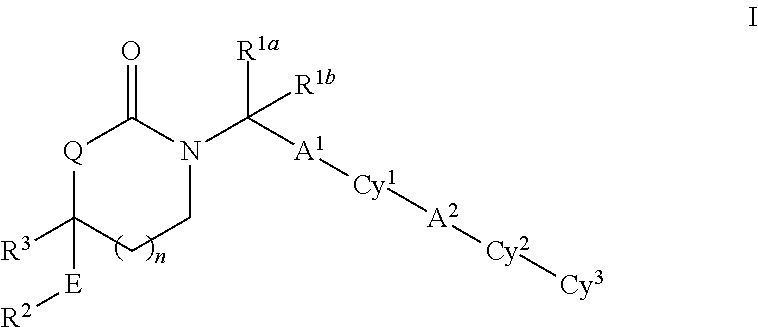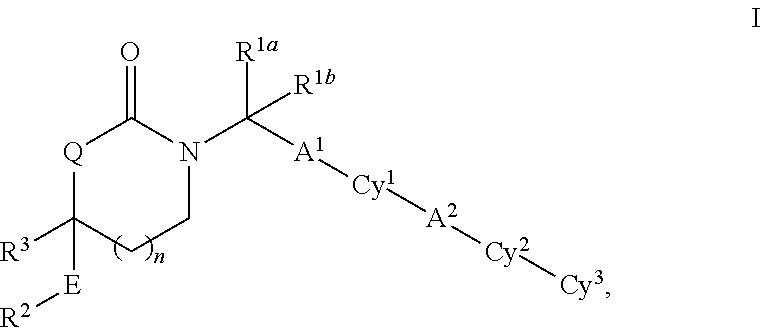Substituted 5-,6- and 7-membered heterocycles, medicaments containing such compounds, and their use
a heterocycle and compound technology, applied in the direction of drug compositions, antibacterial agents, metabolism disorders, etc., can solve the problems of impaired glucose tolerance and/or type 2 diabetes, adverse effects on skeletal tissues, and loss of partial visual field and eventually blindness, and achieve suitable pharmacological and pharmacokinetic properties
- Summary
- Abstract
- Description
- Claims
- Application Information
AI Technical Summary
Benefits of technology
Problems solved by technology
Method used
Image
Examples
example 1
(S)-6-(2-Hydroxy-2-methyl-propyl)-3-{(S)-1-[4′-(3-hydroxy-oxetan-3-yl)-biphenyl-4-yl]-ethyl}-6-phenyl-[1,3]oxazinan-2-one
[0368]
[0369]2 M aqueous Na2CO3 solution (0.21 mL) was added to a solution of (S)-6-(2-hydroxy-2-methylpropyl)-6-phenyl-3-{(S)-1-[4-(4,4,5,5-tetramethyl-1,3,2-dioxaborolan-2-yl)phenyl]-ethyl}-1,3-oxazinan-2-one (100 mg) and 3-(4-bromo-phenyl)-oxetan-3-ol (53 mg) in N,N-dimethylformamide (2 mL). The resulting mixture was sparged with argon for 10 min prior to the addition of [1,1′-bis(diphenylphosphino)ferrocene]-dichloropalladium(II) dichloromethane complex (17 mg). The mixture was heated to 100° C. and stirred at this temperature for 4 h. After cooling to ambient temperature, water was added and the resulting mixture was extracted with ethyl acetate. The combined organic extracts were washed with brine, dried (MgSO4), and concentrated. The residue was purified by HPLC on reversed phase (acetonitrile / water) to afford the title compound as a foam-like solid. Yield: ...
example 2
1-[5-(4-{(S)-1-[(S)-6-(2-Hydroxy-2-methyl-propyl)-2-oxo-6-phenyl-[1,3]oxazinan-3-yl]-ethyl}-phenyl)-pyridin-2-yl]-cyclopropanecarbonitrile
[0370]
[0371]The title compound was prepared from (S)-6-(2-hydroxy-2-methylpropyl)-6-phenyl-3-{(S)-1-[4-(4,4,5,5-tetramethyl-1,3,2-dioxaborolan-2-yl)phenyl]-ethyl}-1,3-oxazinan-2-one and 1-(5-bromo-pyridin-2-yl)-cyclopropanecarbonitrile following a procedure analogous to that described in Example 1. Yield: 16% of theory; Mass spectrum (ESI+): m / z=496 [M+H]+; 1H NMR (400 MHz, DMSO-d6) δ 0.81 (s, 3H), 1.18 (s, 3H), 1.47 (d, J=7.0 Hz, 3H), 1.70-1.74 (m, 2H), 1.81-1.85 (m, 2H), 2.02 (s, 2H), 2.11-2.20 (m, 1H), 2.38-ca. 2.50 (m, 2H) superimposed by D3CSOCHD2 signal, 3.03 (mc, 1H), 4.23 (s, 1H), 5.44 (q, J=7.0 Hz, 1H), 6.98 (d, J=8.3 Hz, 2H), 7.26-7.39 (m, 5H), 7.44 (d, J=8.3 Hz, 2H), 7.60 (d, J=8.3 Hz, 1H), 8.03 (dd, J=8.3, 2.4 Hz, 1H), 8.73 (d, J=2.0 Hz, 1H).
example 3
1-[5-(4-{(S)-1-[(S)-6-(2-Hydroxy-2-methyl-propyl)-2-oxo-6-phenyl-[1,3]oxazinan-3-yl]-ethyl}-phenyl)-pyridin-2-yl]-cyclopropanecarboxylic acid amide
[0372]
[0373]The title compound was prepared from (S)-6-(2-hydroxy-2-methylpropyl)-6-phenyl-3-{(S)-1-[4-(4,4,5,5-tetramethyl-1,3,2-dioxaborolan-2-yl)phenyl]-ethyl}-1,3-oxazinan-2-one and 1-(5-bromo-pyridin-2-yl)-cyclopropanecarboxylic acid amide following a procedure analogous to that described in Example 1. Yield: 47% of theory; LC (method 2): tR=3.35 min; Mass spectrum (ESI+): m / z=514 [M+H]+.
PUM
| Property | Measurement | Unit |
|---|---|---|
| temperatures | aaaaa | aaaaa |
| temperatures | aaaaa | aaaaa |
| temperatures | aaaaa | aaaaa |
Abstract
Description
Claims
Application Information
 Login to View More
Login to View More - R&D
- Intellectual Property
- Life Sciences
- Materials
- Tech Scout
- Unparalleled Data Quality
- Higher Quality Content
- 60% Fewer Hallucinations
Browse by: Latest US Patents, China's latest patents, Technical Efficacy Thesaurus, Application Domain, Technology Topic, Popular Technical Reports.
© 2025 PatSnap. All rights reserved.Legal|Privacy policy|Modern Slavery Act Transparency Statement|Sitemap|About US| Contact US: help@patsnap.com



